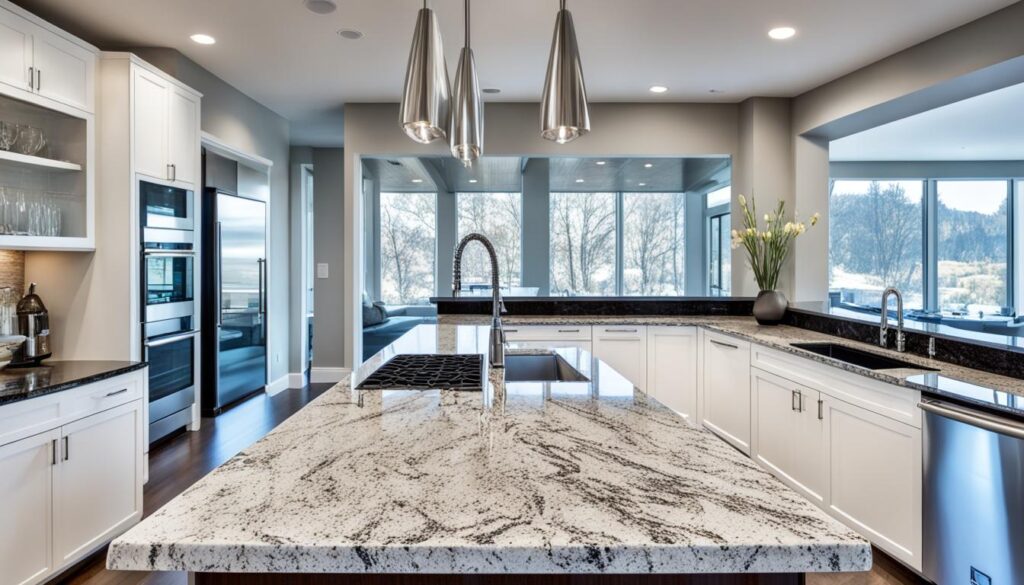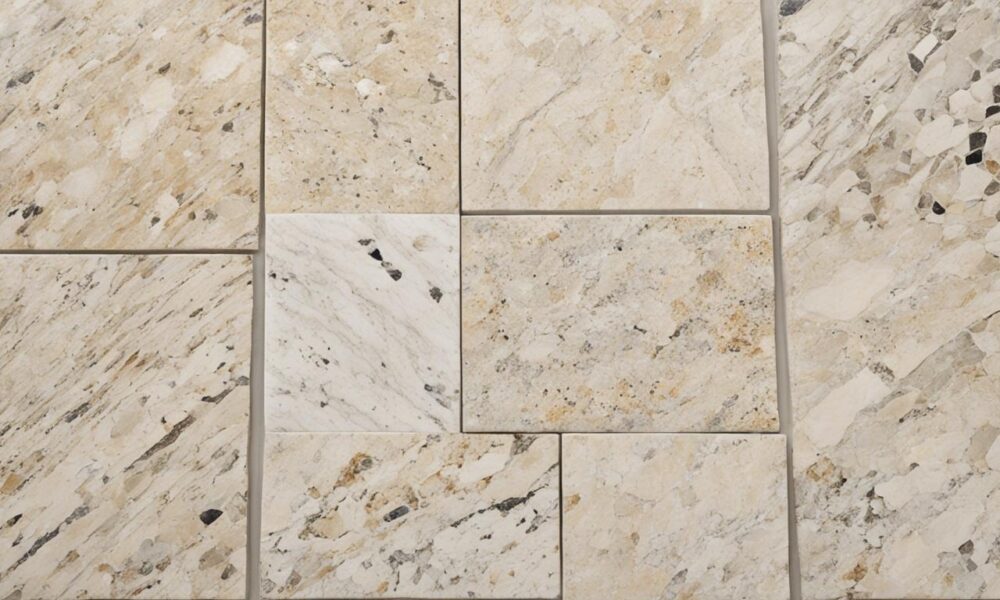Pros & Cons of Natural Stone Types for Home Use
Natural stone flooring is known for its beauty and durability. It’s perfect for both inside and outside your home. People love marble, granite, travertine, limestone, and sandstone. These come from the earth itself. They blend indoor and outdoor areas well and keep temperature just right in any weather. They also last a long time, saving you the hassle of replacing them often.
Natural stone floors help keep your home free from allergens and dust. This makes for a healthier place to live. Each stone tile is unique, offering unlimited design choices1. But, these beautiful floors can be pricey and need careful upkeep. They can also be hard and cold, which might be risky or uncomfortable at times.
Stone flooring prices vary, with some types going as high as $47 a square foot. They have to be sealed to avoid water damage1. Even with the extra work and cost, their timeless appeal keeps them popular among many2.
Key Takeaways
- Natural stone advantages include durability, unique aesthetics, and temperature regulation properties.
- Popular types are marble, granite, travertine, limestone, and sandstone2.
- Maintenance and professional installation are crucial to preserving its beauty3.
- The high costs and potential safety concerns are significant considerations for homeowners.
- Sealing is necessary to protect against water damage and maintain longevity1.
Introduction to Natural Stone Types
Natural stone tile adds class and beauty from nature, offering many choices. Finding the right stone for floors means knowing each type’s traits. Stones like marble and granite last for centuries4. Their surfaces stop dirt from building up, making them great for clean spaces5.
The market for natural stone is growing, set to hit $60,367.30 million by 20306. Each stone type looks unique, giving many design options. In 2021, the Asia-Pacific market made $19,907,200.00, expected to double by 20306. But, natural stone can chip, stain, and get water damage. It needs regular sealing4. Fixing it costs a lot. Even replacing tiles is hard as matching them is difficult4.
Natural stone lasts longer than fake stone and has beautiful patterns5. But, it’s heavy and needs a strong floor underneath, which can be expensive. Over time, the wear shows more. So, picking the right stone matters for happiness in the long run4.
Pros and Cons of Granite
Granite has become a top choice for kitchen countertops. Its long history and strength place it among the best picks.
Advantages of Granite
Granite shines because of its hardness. It is made mostly of strong minerals like silica. This makes it tough against scratches7. It can also take heat, letting you put hot pans on it without damage7. Plus, it keeps up well with high temperatures, making it great for kitchens8.
Granite needs little upkeep, with sealers lasting over a decade7. Sealing regularly fights stains and stops bacteria8. Its natural look brings elegance to any room. There are many colors and designs to match your style.

Granite is also eco-friendly. A single quarry can supply stone for many projects for years7. It’s healthier than some man-made materials that may have harmful chemicals7. Plus, it resists chemicals and doesn’t get damaged by acids or bases7.
Disadvantages of Granite
But, granite has its downsides. It’s heavy and needs a strong foundation. Imperfections in the foundation can damage it over time. Setting it up takes a lot of work and time because it must be placed and sealed just right.
Granite’s look might be hard to match for repairs. Some rare types can be very expensive7. On the cheaper side, it competes with luxurious laminates in price7. Think about these pros and cons when choosing your countertop material.
Pros and Cons of Marble
Marble, when compared to quartz, stands out with its timeless beauty. It is a natural stone that makes any room look luxurious. Its rich calcium carbonate composition adds immense value to any space.
Advantages of Marble
Marble countertops have unique patterns and many colors. Every slab is like a unique piece of art9. It’s 100% natural and found worldwide, making it very appealing9.
You can find marble in various colors, including black and white9. It’s great for kitchens because it can handle high heat9. If you keep marble in good shape, it can also make your property more valuable9.
When sealed right, it can resist stains from things like wine or oil9. This makes marble a top pick for luxurious floors in homes and businesses.

Disadvantages of Marble
But marble has its downsides too. It can scratch and crack easier than other stones9. You need to take good care of it to keep it looking nice. Marble must be sealed often to avoid damage from water and stains9.
It’s also not great with acid. Things like some cleaners or acidic foods can damage it. That’s why choosing the right products for cleaning is key.
Even though there’s a debate between marble and quartz, marble needs more upkeep. It’s not the best if you want flooring that’s easy to take care of.
For more insights on marble’s pros and cons, a deeper look can help you decide if it’s right for you.
Pros and Cons of Different Natural Stone Types
Exploring natural stone types for home use shows a wide range of choices. Each type boasts its own benefits. For a detailed stone types comparison, check out available resources to help make the right flooring choice.
Granite is super hard and resists heat and scratches well but needs sealing because it’s porous10. Quartzite requires little upkeep and resists UV rays. It’s tough and scratch-resistant, but some types need sealing and might stain10.
Marble is valued for being fixable and long-lasting with care but can stain easily due to porosity10. Porcelain tiles are good against UV rays and heat, and they don’t stain easily. However, they can crack if dropped10.
Dekton is a strong choice, fighting off scratches, heat, and stains. It also protects against UV rays and ice but is hard to fix if it breaks10. Quartz is durable like granite and doesn’t stain, but it doesn’t do well with heat and harsh chemicals10.
There are more exotic options like travertine, known for being slip-resistant. It’s softer and needs careful sealing. Limestone showcases warm colors but also needs sealing against stains. Sandstone adds rustic beauty but is soft and erodes over time. Slate is perfect for busy areas but might need sealing sometimes.
When diving into the realm of natural stone, it’s key to think about your lifestyle and what you like. Consider what you need functionally from your flooring. Remember, taking care of your stone floors is essential for their beauty and lifespan.
FAQ
What are the advantages of using natural stone for flooring?
What are the common types of natural stone used for home flooring?
What are the pros and cons of granite as a flooring material?
How does marble compare to quartz for flooring?
What should homeowners consider when choosing the right stone for flooring?
What are the drawbacks of natural stone flooring?
What is the cost range for natural stone flooring?
How do the maintenance requirements differ among natural stone types?
Are there any specific considerations for using natural stone in high-traffic areas?
Source Links
- Pros and Cons of Natural Stone Flooring in Your Kitchen
- The Difference Between Natural Stones – Room for Tuesday
- Pros and Cons of Natural Stone Flooring in Layman Terms
- Key Differences Between Engineered and Natural Stone Countertops: Which is Right for Your Kitchen? | Milwaukee Marble Granite
- 2 Types of Stone : Natural Stone & Artificial Stone
- Types of Natural Stone Commonly Used In Construction
- Pros & Cons of Granite | Factors You Should Consider
- 16 Must-Know Pros and Cons of Granite Countertops
- Pros and Cons of Marble
- The Pros and Cons of Stones



